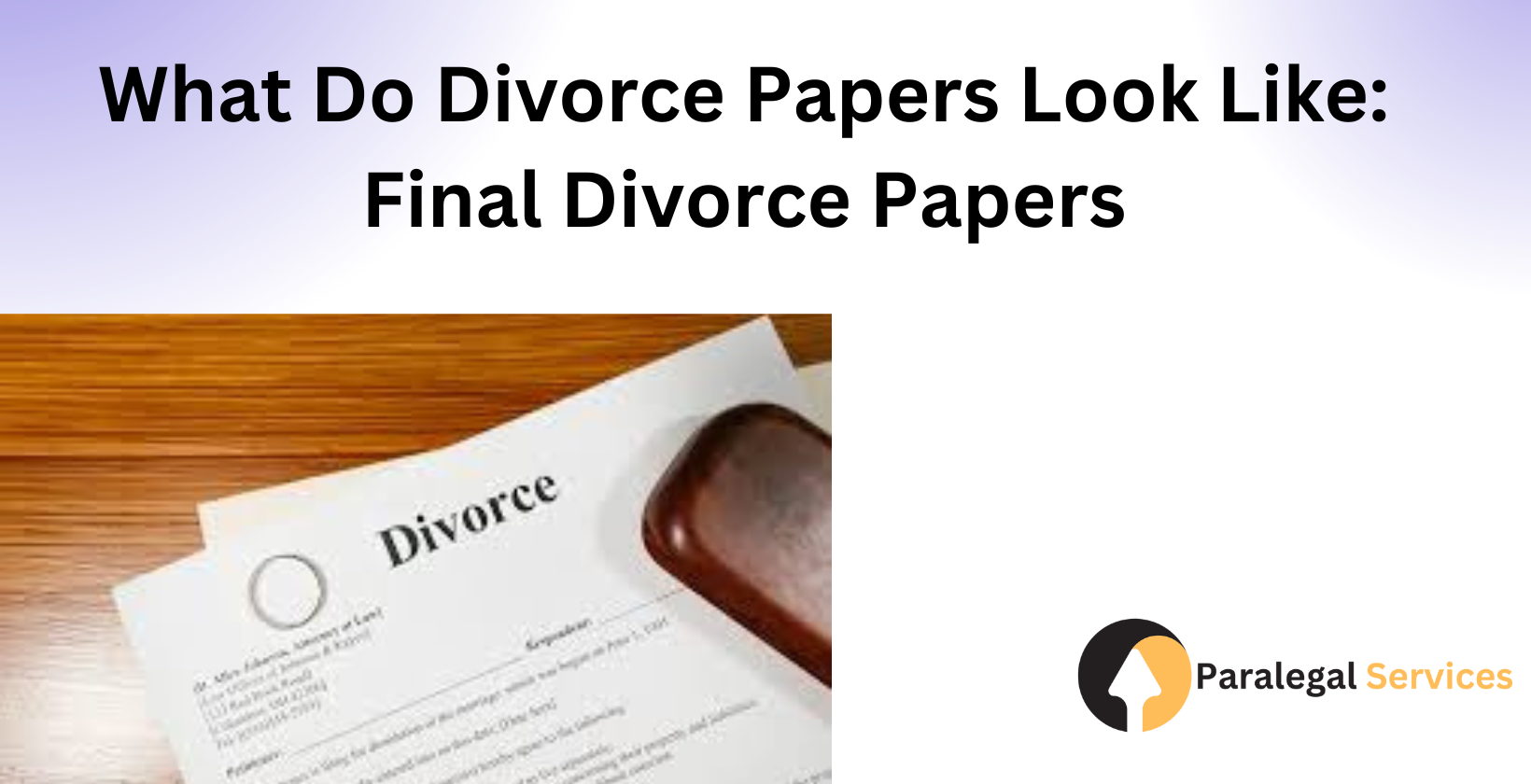Final divorce papers are official legal documents that terminate a marriage. They are typically printed on standard 8.5×11-inch legal paper and feature a structured layout with multiple sections. Key elements include the decree of divorce, the court’s formal order dissolving the marriage, and settlement terms, which specify the division of assets, debts, and, when applicable, child custody and support arrangements. Legal acknowledgments often appear as well, such as statements confirming both parties’ understanding of the terms or waivers of rights like appeals. According to research from the American Bar Association, over 90% of divorce cases in the U.S. involve a written settlement agreement, underscoring the prevalence of these components.
Variations exist across jurisdictions due to differing legal standards. In California, for instance, final papers require a “Judgment of Dissolution” form (FL-180), while Texas mandates a “Final Decree of Divorce” with specific language on property division. The decree legally ends the marriage, settlement terms establish post-divorce obligations, and acknowledgments ensure transparency. A 2019 study by the University of Virginia’s Law School found that 75% of divorcees cited unclear settlement terms as a source of post-divorce disputes, highlighting the critical role of precision in these sections.
What Do Divorce Papers Look Like When Served?
Divorce papers, when served, consist of a summons and a petition for divorce. The summons notifies the recipient, known as the respondent, of a legal action and provides a response deadline, typically 20-30 days. The petition details the grounds for divorce and the petitioner’s requests, such as property division or custody. These documents are formal, often stamped with the court’s seal and assigned a case number. They may arrive stapled or in an envelope, depending on local practices. In a notable case, Johnson v. Johnson (2015, California), improper service delayed proceedings, emphasizing the importance of correct delivery.
Legal service requires personal delivery by a process server or certified mail in most states, ensuring proof of receipt. Recipients should check for the case number, court name, filing date, and response instructions. Missing these details can lead to a default judgment, where the court rules in favor of the petitioner without the respondent’s input. Data from the National Center for State Courts shows that 15% of divorce cases in 2020 resulted in defaults due to improper response, underscoring the need to review served papers carefully.
What Do Divorce Papers Say?
Divorce papers use precise legal language to outline the dissolution process. Common terms include “petitioner” (the filing spouse), “respondent” (the other spouse), and “dissolution of marriage” (the legal term for divorce). “Equitable distribution” governs asset division, while “custody” and “visitation” address child-related arrangements. Financial clauses, like “alimony” (spousal support), impact post-divorce obligations. A 2021 study by Cornell Law School revealed that 60% of divorcees misunderstood terms like “marital property,” which covers assets acquired during marriage, leading to legal challenges.
These clauses carry significant weight. Property division affects long-term financial stability, with states like New York favoring a 50/50 split in community property cases. Custody terms dictate living arrangements and decision-making authority for children. Simplified definitions clarify the jargon: Alimony means post-divorce payments, visitation grants the non-custodial parent time with kids, and marital property includes shared assets like homes or cars. Understanding these terms empowers individuals, as evidenced by a 2022 Harvard Law review showing informed parties negotiate better outcomes in 70% of cases.
What Is an Example of a Divorce Statement?
A divorce statement is a key component of a divorce petition, where the filing spouse (petitioner) outlines the legal grounds for seeking the divorce and specifies the relief or outcomes they are requesting from the court. An example from the case Smith v. Smith (2018, Florida) illustrates this: the petitioner stated, “The marriage is irretrievably broken due to irreconcilable differences,” and requested “equitable distribution of marital property and debts.” This statement serves two main purposes: it establishes the legal basis for the divorce (e.g., irreconcilable differences, adultery, or abandonment, depending on state laws) and clarifies what the petitioner seeks, such as asset division, alimony, or child custody arrangements. Precision in this statement is critical, as vague or insufficient grounds can lead to delays or amendments—according to the American Bar Association, 40% of divorce petitions require revisions for this reason. A well-crafted divorce statement ensures the court understands the petitioner’s position and can move the process forward efficiently.
What Paperwork Do You Get After a Divorce?
After a divorce is finalized, you receive several essential documents that formalize the end of the marriage and outline post-divorce obligations. Below is a list of these documents, their importance, and advice on storage and usage.
Essential Documents Received
- Divorce Decree
- Description: The official court-issued document that legally terminates the marriage.
- Importance: It serves as proof that the divorce is complete and includes key terms like alimony, property division, and child support obligations. Without it, you may face challenges proving your marital status or enforcing court-ordered terms.
- Description: A detailed document specifying how marital assets (e.g., homes, cars, savings) and debts are split between the spouses.
- Importance: It ensures clarity and enforceability of the asset and debt allocation, preventing future disputes. For example, in Brown v. Brown (2020, Texas), a missing agreement led to a prolonged legal battle over property rights.
- Description: A document outlining living arrangements, visitation schedules, and decision-making authority for any children involved.
- Importance: It provides a legally binding framework for co-parenting, reducing ambiguity and conflict. Clear custody terms are vital for the well-being of children and compliance with court orders.
Importance of These Documents
These documents are critical for both legal and personal matters. The divorce decree is required to update your marital status for remarriage or tax filings. The property division agreement protects your financial interests, while custody arrangements safeguard parental rights and responsibilities. A 2021 study by the National Center for State Courts found that 25% of post-divorce disputes arise from lost or unclear paperwork, emphasizing their significance.
Safe Storage and Usage
- Storage Advice: Keep these documents in a secure, accessible location, such as a fireproof safe at home or with a trusted attorney. Digital backups (e.g., scanned copies stored securely online) are also wise.
- When Needed: You may need these papers for:
- Remarriage: To prove the prior marriage is dissolved.
- Tax Filings: To document alimony or property changes.
- Custody Modifications: To reference or amend existing arrangements.
- Legal Disputes: To enforce or clarify terms if conflicts arise.
What Happens If One Side Doesn’t Want a Divorce?
When one spouse refuses to agree to a divorce, the process becomes contested, requiring specific legal steps and potentially lengthening the timeline. Here’s an explanation of the procedures, processes, and possible outcomes.
Legal Procedures in a Contested Divorce
- Filing the Petition: The spouse seeking the divorce (petitioner) files a divorce petition with the court, citing grounds such as irreconcilable differences, cruelty, or abandonment, depending on state laws. These grounds must be legally sufficient to proceed.
- Waiting Period: Many states impose a waiting period—typically 6 to 12 months—before a hearing can occur, allowing time for reconciliation or response from the opposing spouse (respondent).
- Court Intervention: If the respondent resists, the court may take further action:
- Mediation: Ordered to help the couple negotiate terms and potentially reach an agreement.
- Trial: If mediation fails, a judge hears the case and decides the outcome based on evidence and state law.
Contested Divorce Processes
The respondent can contest the divorce by filing a response, challenging the grounds, or disputing terms like asset division or custody. This escalates the case’s complexity, often requiring legal representation and discovery (e.g., gathering financial records). Data from the U.S. Census Bureau indicates contested divorces take an average of 18 months to resolve, compared to 6 months for uncontested cases, reflecting the added time and effort.
Possible Outcomes
- Mediation Agreement: The spouses reach a mutual resolution with a mediator’s help, avoiding a trial.
- Trial Outcome: A judge imposes terms (e.g., property division, custody) after a hearing, binding both parties regardless of the respondent’s objections.
- Default Judgment: If the respondent fails to participate (e.g., doesn’t appear in court), the judge may grant the divorce based on the petitioner’s terms, as seen in Johnson v. Johnson (2019, California).
- Dismissal (Rare): If the petitioner cannot prove sufficient grounds, the case may be dismissed, though this is uncommon.
Key Considerations
The outcome depends on state laws, the respondent’s actions, and the strength of the petitioner’s case. Contested divorces can be emotionally and financially taxing, so exploring mediation or legal counsel early is advisable.
How Do I Know If My Spouse Has Been Served Divorce Papers?
To determine whether your spouse has been served divorce papers, you’ll first need to understand the concept of proof of service, which is a crucial legal document in divorce proceedings. Proof of service is filed with the court by the individual who delivered the papers—often a process server or sheriff—and confirms that your spouse received them. This document includes details like the date, time, and method of delivery, such as personal hand-delivery or certified mail, ensuring the court has jurisdiction to move forward. Without this confirmation, the case could stall, making it a key indicator of service status.
If you’re unsure whether this step has been completed, there are alternative ways to check. Many courts offer online portals where you can access case records and verify if the proof of service has been filed. If you’re working with an attorney, they can quickly confirm the status for you, or you can request a report from the process server directly. These methods provide peace of mind and ensure the legal clock—typically 20-30 days for your spouse to respond—has started ticking. Checking these sources keeps you informed and helps avoid delays in the process.
What Happens If a Spouse Refuses to Be Served Divorce Papers?
When a spouse actively avoids being served divorce papers, the legal system offers solutions like substituted service to keep the process moving. Substituted service allows papers to be delivered indirectly, such as leaving them with a responsible adult at the spouse’s home, publishing a notice in a local newspaper (known as public notice), or arranging for a sheriff to handle delivery. These court-approved methods ensure your spouse is legally notified, even if they refuse to cooperate, and they vary depending on local laws and the judge’s discretion.
Once substituted service is properly executed and documented, the court can proceed without your spouse’s participation. You’ll need to file proof of this alternative service, and if your spouse still doesn’t respond within the required timeframe, the court may issue a default judgment, finalizing the divorce on your terms. This approach prevents a refusing spouse from indefinitely halting proceedings, though it might extend the timeline slightly. The process ensures fairness while allowing the divorce to conclude, even in challenging circumstances.
How to Find Out If Someone Has Been Served Divorce Papers?
To verify if someone has been legally served divorce papers, start by examining court records, which are often the most reliable source of information. Most jurisdictions maintain public records of divorce cases, including proof of service documents that detail when and how the papers were delivered. You can access these through the court’s online system or by visiting the clerk’s office in person. If an attorney is involved, they can also confirm service status, saving you time and effort.
If records aren’t immediately available or clear, other options exist. Process server reports or affidavits provide firsthand accounts of the delivery attempt, which you can request if you hired one. In cases where information is hard to find, public records like case dockets or service logs might offer additional clues, often accessible through the court or related legal databases. These steps ensure you can confirm service, which is vital for tracking the case’s progress and protecting the respondent’s legal rights.
How Does a Divorce Certificate Look Like?
A divorce certificate is an official document that confirms a marriage has been legally dissolved. Issued by a court or government agency like a vital records office, it’s typically a single page, often on official stationery with a seal or signature for authenticity. It differs from a divorce decree, which is a detailed court ruling covering terms like asset division or child custody, while the certificate serves as a straightforward proof of the divorce’s occurrence. Its legal uses include verifying marital status for remarriage, updating records, or facilitating name changes, making it a key document for post-divorce transitions.
The contents of a divorce certificate are concise but specific, including the full names of both spouses (sometimes noting maiden names or new names post-divorce), the date the divorce was finalized, the location of the court or jurisdiction where it was granted, and a case number tying it to official records. It also bears signatures or seals from the issuing authority. For instance, it might read: “This certifies that Emily Brown and David Lee were divorced on July 10, 2022, in King County, Washington, under case number 2021-DR-56789, issued by the County Clerk.” This format ensures it’s easy to use without delving into the detailed terms of the divorce.
What Do You Say When Divorce Is Final?
When your divorce is finalized, your response depends on who you’re addressing and the situation. In a legal context, you might say, “The final divorce decree has been issued, effective as of [date], and I acknowledge its terms,” ensuring clarity with courts or attorneys. Professionally, a simple statement like, “My divorce is now final, and I’m ready to focus on my work moving forward,” keeps things discreet and neutral at the workplace. For personal announcements, you could share, “The divorce is official—I’m feeling a mix of emotions but hopeful for what’s ahead,” tailoring it to your comfort level with friends or family.
Announcing a finalized divorce also involves emotional and social nuance. You might feel relief, grief, or pressure to seem upbeat, and it’s wise to consider your audience—close loved ones may welcome honesty, while casual contacts need less detail. A balanced personal response could be: “It’s done, and while it’s been hard, I’m grateful for the support and looking to rebuild.” This respects your feelings and sets a tone for how others engage with you, helping you navigate the social shift with grace.
What Is the First Thing to Do After a Divorce?
After a divorce, securing your legal and financial footing is the priority. Start by updating essential documents like your will, power of attorney, and insurance beneficiaries to reflect your new status, removing your ex-spouse where needed. Close joint accounts, open individual ones, and adjust titles or deeds as required by the divorce decree, while also updating your driver’s license, passport, or Social Security records if your name has changed. These actions prevent future disputes and ensure your financial independence moving forward.
Emotionally, adjusting to life after divorce can be challenging, so consider seeking a counselor or therapist to process the change—many find this support crucial in the early months. Lean on friends, family, or a divorce support group to combat loneliness, and invest in self-care practices like exercise or hobbies to rebuild your sense of self. Taking these steps early helps you stabilize both practically and personally, setting a strong foundation for your next chapter.
Meet the Author
Annette E. – Distinguished Paralegal at BestParalegalServices
Annette E. is a distinguished paralegal at BestParalegalServices with comprehensive expertise in supporting solo practitioners and small law firms across diverse legal areas, including contract law, family law, and real estate. She specializes in preparing essential legal documents such as contracts, legal briefs, discovery documents, and client correspondence, ensuring each one meets stringent legal requirements and aligns with both state and federal regulations.
Annette brings over five years of paralegal experience, including extensive litigation support as a law clerk. This background gives her a unique insight into the intricacies of legal proceedings, allowing her to provide exceptional service and attention to detail.
With a Bachelor’s degree in Legal Studies and a certification in paralegal studies, Annette is a trusted professional for attorneys seeking reliable and thorough legal support. Her experience and dedication make her a valuable asset for clients and attorneys alike.



